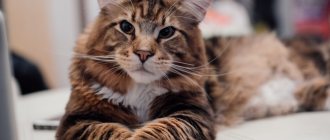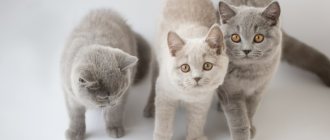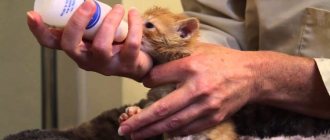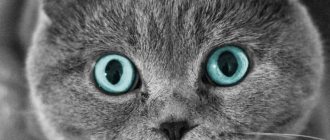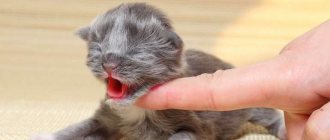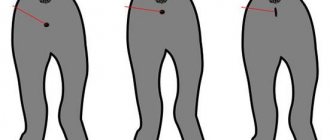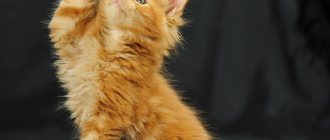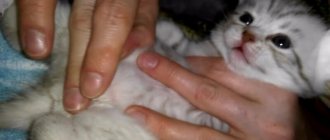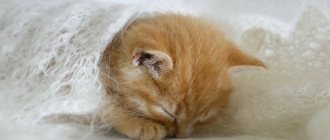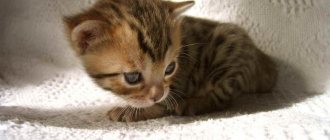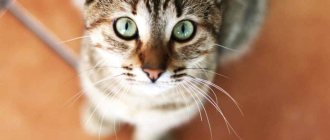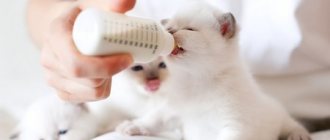Scottish Folds have an unusual appearance, but in early childhood they are very similar to British Shorthair cats. Newborn cats can be Scottish and Highland, Straight and Fold. But it is impossible to immediately find out what shape the baby’s ears will be. Let's find out by what signs and at what age you can determine the presence of lop ears in a kitten.
Advantages and disadvantages
The positive qualities of an animal include its character: the cat has a calm disposition and is friendly.
The Scotsman is hospitable and treats people with respect. The Scots, thanks to their extraordinary intelligence, are easy to train; their courage allows the animals to perform at various exhibitions. A cat can be taught to give a paw, walk on its hind legs, and perform simple tricks.
Fold cats easily learn to use the litter box and tolerate water treatments. Some individuals happily swim in open water sources.
One of the disadvantages is the price of the breed. If you are going to purchase a purebred animal, you will have to shell out an amount of up to 40 thousand rubles. Cats without a pedigree are much cheaper, about 4 thousand rubles, but this does not guarantee that they will sell you a Scotsman and not an animal with surgery performed on the ears. Moreover, such individuals may experience serious health problems in the future.
Other disadvantages include the health of purebred cats. Some Scots suffer from osteochondroplasia. This is a hereditary disease associated with damage to the bone tissue of the joints, cartilage, and manifests itself as a slowdown in bone growth. This disease can be fatal.
Other common diseases of Scottish Folds: chondrodystrophy, arthritis, arthrosis. These diseases usually occur due to improper mating of animals. Therefore, before buying an animal, you should carefully study the pedigree of the animal, right down to the cat’s ancestors. Scots may also suffer from entropion. Adult animals are susceptible to the development of glaucoma and cataracts.
Like all animals, the fold-eared breed may show signs of allergies, mange, or skin eczema. Deafness is also an eternal companion of the breed; it can be complete or partial. Diseases of the cardiovascular and digestive systems, and the bladder develop in old animals or when the cat is not properly cared for.
Diseases of the breed
The life expectancy of Scottish Fold cats is from 10 to 15 years. In order for your animal to live a long and healthy life, it is necessary to visit a veterinarian promptly, receive appropriate vaccinations, have joints checked, and follow the veterinarian's advice. The breed has some underlying health problems.
Hypertrophic cardiomyopathy
Hypertrophic cardiomyopathy is a hereditary heart disease. Symptoms:
- tachycardia;
- dyspnea;
- heavy breathing with wheezing;
- pulmonary edema;
- fainting;
- failure of the pelvic limb; in rare cases, both limbs may fail;
- high blood pressure.
The disease is diagnosed by measuring blood pressure at a veterinarian, undergoing echocardiography (data on the functionality of the heart is revealed), visual assessment, x-ray diagnostics, and electrocardiography. Animals in serious condition should be treated only in a hospital hospital, where there are all conditions for such cats. A veterinarian examines the animal’s condition and prescribes treatment, light physical activity and a special diet. If the animal feels better, it can be treated at home, unquestioningly following all the instructions of the treating veterinarian. The problem can be cured, but such cats will always have to be checked by veterinary cardiologists.
Degenerative joint disease
This disease is characterized by the fact that pain is present in the tail (most often) and the mobility of the limbs is reduced. Symptoms:
- obvious lameness;
- the cat’s reluctance to jump on chairs or sofas;
- it is difficult for a cat to get up from the floor after resting;
- frequent and prolonged licking of joints when washing;
- the cat becomes irritable and may hiss, scratch or bite.
The disease is treated with anti-inflammatory non-steroidal drugs; if the disease is advanced, antibiotics are prescribed. Additionally, a diet may be prescribed.
Osteochondrodysplasia
It is expressed in deformation of the paws, skeleton, and immobility of the tail. Symptoms:
- lameness (may pass and reappear, and an animal with illness will not be able to jump on high ground);
- squat appearance;
- stiff gait;
- acute reaction to touching the tail;
- severe deformation of the hind limbs;
- unsteady gait.
Treatment is aimed at eliminating symptoms with medication. In the absence of polycystic kidney disease, a non-steroidal anti-inflammatory drug can be prescribed; it will relieve the cat of pain and reduce inflammation. Additionally, vitamin complexes and special supplements are prescribed. In the UK, such sick cats undergo irradiation of their extremities; for a long time the cat can calmly walk, run and jump. In Russia there are no such technologies, so such operations are not carried out.
What the owner should know
In order for the offspring to be healthy, you need to know some features of mating Scottish Folds:
You need to select a partner of a similar breed, that is, Scottish, but not Scottish Fold. In this case, the best option would be Scottish Straight. This breed of cat has straight ears. If a Scottish straight-eared cat is mated, then the opposite is true, the cat must be fold-eared.
You cannot cross a Scotsman with a British breed. In this case, the cubs are too large, the tail and head are deformed, and the structure of the coat does not meet the standards.
The male must have a uniform color, good quality coat, and a proportional build. You should definitely pay attention to the tail, it must be flexible. This factor affects the health of the animal’s spine. This way, developmental defects in the baby can be avoided.
You should also pay attention to the cat's ears. It would be correct if they are directed forward, small, widely spaced and do not go beyond the head
An important feature is the ear folds, it is very good if they exist. Such breeds are considered unique
It is best if there are two of them, and they are tightly folded on the head. It is very rare to meet a Scot who has three such folds.
It is important to assess the health of the male; he should not have dandruff or any discharge from the eyes, nose or ears. The animal should not be emaciated or too large, everything should be within normal limits.
shutterstock
Many owners of Scottish cats begin to look for a partner through advertisements. This method is not bad; you can select a suitable candidate. But there is another simple way: breeder clubs that specialize in Scottish Folds. The specialists working there will be able to help you choose a suitable male and tell you about his characteristics. By choosing this method of mating, you can be sure of healthy offspring.
Before mating, it is advisable to agree on the amount of the cat’s owner’s fee. He usually gets one baby, which has straight ears. There are always fewer fold-eared kittens; it very rarely happens that all the cubs from one litter are straight. If this is the case, then the cat’s owner receives money as a reward. The amount is equal to the cost of a Scottish Fold kitten.
Before mating, it is advisable to personally make sure that both partners are treated for worms and other parasites. It is permissible to treat the cat before intercourse for diseases such as rabies, chlamydia and other diseases, as well as to prevent worms.
The room where the whole process takes place must be clean, bright, dry and spacious, and it must be warm. The intercourse of animals can last several days, so you need to be prepared for the trip. You need to take with you a tray with filler, bowls for food and water, and the food itself. It happens that a cat is very aggressive, so before mating you need to trim its claws.
Your cat may not get pregnant the first time. In this case, it is necessary to bring her to the cat on the 2-3rd day of the next estrus and leave her there for a couple of days. In one day, a cat can cover a female up to 14 times, but after a few days he ceases to be interested in her.
What should a cat normally do?
If everything is fine with the animal after giving birth, it will definitely take care of the offspring that are born: the cat’s task is to remove the remnants of the placenta from the kittens, lick them and push them in the direction of the nipples.
First, your pet carefully licks her babies, first of all freeing their eyes and nose from the mucus that got there during the birth process. After this, the animal takes the umbilical cord into its mouth and, chewing it (at the same time, the umbilical cord is effectively crushed), chews it. In addition, “experienced” women in labor carefully lick the umbilical area: the saliva that gets into the wound, rich in antibacterial substances, prevents the development of inflammation.
Finally, the cat carefully and diligently licks the anal area of each kitten individually. She does this for the effective removal of original feces. If the babies are not very “smart,” your pet will definitely push them towards the nipples. It is interesting that breeders have long made a simple and logical conclusion: kittens that “without prodding” accurately determine the direction of the “milk fountains” are 100% likely to grow up to be the largest and physically strongest.
Note that cats constantly nurse their babies for about an hour or two from the moment the latter is born. Since their eyes begin to open somewhere towards the end of the first week, the mother deliberately lies sideways to her babies so that they can always find nipples with milk. If your pet exhibits restless behavior and cannot calm down, forcefully put it down.
- After about two weeks, the cat no longer “indulges” the cubs so much, and only lies down to feed when they all start poking at her stomach at once.
- Starting from the age of four or five weeks, when the offspring have long and sharp teeth, the mother increasingly refuses to feed them and runs away, sometimes hissing indignantly.
- By eight weeks, kittens can be completely weaned and finally transferred to “adult” food.
Be sure to watch whether the cat licks the genital area of newborn kittens: for about three days, the instincts that promote natural bowel and bladder emptying do not work in babies, and therefore the mother must induce these processes artificially.
And she also has the unpleasant responsibility of eating all the excreted feces and urine (natural expediency - so that there is no smell of anything around the den). However, in practice such care often lasts much longer than three days, and the cat stops licking the “private” areas of her kittens only after the babies themselves can crawl outside the place of their birth.
Loss of characteristic: when the ears rise
Straight-eared kittens are called straights, and fold-eared kittens are called folds. The clear difference between them lies in the presence and number of folds on the ears. One fold causes the ears to straighten over time. This does not mean that the kitten is straight. To answer the question about his breed, an examination is carried out. It is especially important for owners who plan to crossbreed kittens. An incorrect conclusion about the straightness of an animal leads to the crossing of two lop-eared individuals and sick offspring. If there are two folds, then it is impossible to predict the outcome: the kitten can remain fold-eared with the same success as become straight-eared. Three folds ensure the ears don't straighten out.
External differences between British and Scottish cats
Folds with erect ears are sterilized to prevent the transmission of a dominant gene that has lost visual expression.
There is a clear sign that distinguishes a fold-eared cat with erect ears from a straight-eared one: the size of the ears. The first one has smaller ones.
Temporary changes in the position of the ears are also possible, the cause of which is weather conditions. The heat causes the Fold's ears to rise slightly.
In addition, the ears of the folds also rise in females after giving birth.
Genetics of differences between Scottish and British cats
At first, the researchers decided that the unusual shape of the auricle in the Scotsman was the result of an autosomal dominant trait, but later their opinion changed. The dominance turned out to be incomplete. An allele of a gene on one chromosome only masks or changes the instructions of another locus of the same gene to another copy of the same chromosome.
It sounds complicated, but for the Scots this combination almost turned out to be a death sentence - animals of this breed experienced changes in the functions of the musculoskeletal system, and pathologies of the bones and spine also developed.
A little later, American geneticists got involved in the work, and the differences between the British Fold and the Scottish Fold became more specific:
- A pair of fdfd genes is responsible for the normal shape of an animal’s ears. The British and Scots with this “set” are no different from each other.
- The heterozygous Fd fd model (when one of the parents is straight-eared) leads to the birth of lop-eared kittens, but does not have a negative effect on the health of the pet.
- Negative scenario – homozygous set of FdFd genes. In this case, the difference between the British and Scottish breeds will be not only in the shape of the ears, but also in the presence of pathologies of cartilage and bones.
Character of the breed and behavioral characteristics of Scottish Fold cats.
Cats of this breed are very kind and calm, but also do not allow themselves to be offended. Typically, a fold-eared cat becomes attached to only one owner, expressing this with his affection.
She is quite independent and discreet, and is ideal for those people who are often busy at work and are rarely at home. Due to its reserve, it does not have the playfulness that children so often need, so if you plan to have a pet for a child, it is better to choose a more active and mischievous breed.
They also cannot stand loud noise in the house and love silence and comfort. They meow very rarely, mainly when they really need something, for example, if the bowl is empty.
They have one peculiarity: they can stand on their hind legs for a long time and if they are interested in something, they can watch it for a long time, taking a meerkat pose. It is also interesting that they know how to sit in the Buddha pose when they rest on a bed or on upholstered furniture.
If there are other pets in the house, fold-eared cats will happily make friends with them. They get along well even with dogs.
These are non-conflict animals and can easily endure both trips to exhibitions and visits to the veterinarian.
The only thing they don’t like is guests or strangers in the apartment. In such situations, the fold-eared cat will prefer to hide in another room.
- Calmness and lack of conflict (on the street you rarely see a Scottish Fold fighting with other cats);
- Patience (if the owner is absent for a long time, the pet will not be very nervous, and at the time of feeding it will not meow much);
- Attachment (they get used to the owner and place of residence quite quickly);
- Independence and independence (very rarely they ask the owner for anything and do not bother with whims);
- Moderate emotionality and playfulness;
- Curiosity;
- Intelligence and grace (they are quite smart and if teased, they will prefer to ignore ill-mannered people or animals rather than respond with aggression).
Scottish Folds are an exclusively domestic breed, as they were bred and kept in appropriate conditions. Despite the calmness and lack of aggression, these animals still know how to hunt.
The hunting instinct allows you to easily catch small rodents and large insects.
These animals are amazingly smart and intelligent. They are able to differentiate the information they receive and select only the information they need.
Thanks to this, they are easy to learn and train. The voice and sounds that folds make are not quite like meowing. But this is not a drawback at all, but a distinctive feature of this amazing species.
What documents should there be?
The purebred Scottish Fold cat, as well as its health parameters, must be confirmed by official documents:
- metric or pedigree;
- certificate of registration (for American organizations);
- purchase agreement;
- veterinary passport;
- transfer to own a cat (in rare cases);
- veterinary certificate No. 1 (for imported animals).
Important! A serious nursery will not sell cheap kittens without documents and expensive ones with documents. From a responsible breeder, all animals have documents issued simultaneously for the litter, which is registered as a whole.
If you receive a metric in your hands, the pedigree is no longer needed, and vice versa. But the breeder is obliged to hand over one of these main papers, regardless of the purpose of acquiring the “Scot” - for breeding or castration.
Documentation of the litter in the breed club is strictly regulated, but is inexpensive. All papers received from the breeder minimize your potential risks: you will always return the animal and the money spent if it is found to have congenital anomalies.
Metrics
This is a birth certificate issued after the animal is registered in the club system. The following must be included in the document (where the emblem of the system to which the “Scotsman” is assigned) is affixed:
- Name;
- date of birth;
- gender and breed;
- color;
- names/colors of manufacturers;
- breeder's name and other information.
The European certificate is affixed with the seal of the club and the signature of the responsible person who activated the litter: this is necessary to exchange the metric for the pedigree. In American systems, a slip (metric) is used to register a kitten and obtain a pedigree through the central office.
Pedigree
This includes the kitten’s ancestors (up to 3–5 generations) with their names, colors and pedigree numbers . This document contains the name of the nursery and club, the association's emblem, information about the kitten, as well as the names of the breeder and owner.
Attention! The “owner” column should contain your name, not the name of the breeder. To do this, obtain a pedigree yourself or agree with the breeder to prepare it in advance.
European pedigrees are provided with a number, the seal of the club and the signature of its leader, American pedigrees - only with a number . Pedigree in the USA is informative, and pedigree is confirmed by registering the kitten (and its litter) in the system according to its rules.
In European associations, you may be given a pedigree without a number or marked “pet”, or not at all if you adopted a “Scot” for castration. If you want to draw up a pedigree yourself (provided you have a metric), do it before the pet turns one year old. If you are not going to breed purebred cats, you won't need a pedigree.
Veterinary passport
Information such as:
- name and gender of the kitten;
- breed and date of birth;
- vaccination records (with a veterinary clinic stamp, a special sticker and a doctor’s signature);
- owner/breeder's name.
Despite the fact that a veterinary passport is issued to every purebred animal, it cannot serve as confirmation of the breed: the veterinary passport is filled out by the breeder or doctor, and clubs and felinological associations are responsible for the purity of the breed.
Other documents
All other documents (certificate of registration of the kitten in the system, transfer of ownership, veterinary certificate in form No. 1) are optional, that is, optional. An exception is a purchase and sale agreement, which will protect your rights if an unscrupulous breeder sells you a cat that is known to be sick.
Important! A Scottish Fold cat without documents is not recognized as a purebred cat and is automatically excluded from breeding.
Return to content
External factors
Now let's figure out how to choose a real Scottish kitten. Very often, under the guise of Scots, they sell British or even mongrel children. Before you make a purchase, it’s worth visiting specialized nurseries to get an idea of what Scottish Fold kittens might look like.
Let us note the main external signs of the Scots:
- the fur is short, as if plush;
- very reminiscent of little bear cubs;
- the eyes are round and large, slightly slanted;
- the head looks like a fur ball;
- folds have drooping ears, while straights have straight ears;
- if you look from the side, the mouth “smiles”;
- neat nose;
- ideal representatives of the breed have a “childish” face;
- Parents of children should also have pedigrees.
Scottish cats can come in different colors: you can find black, white “teddy bear” cats, as well as cream, blue and even red. There are a huge number of coat patterns, such as brindle, spotted. There are representatives who have a mixture of colors and patterns.
What age is best to take
The kitten is not separated from its healthy mother for at least two months: during this time, it drinks its mother’s milk, rich in antibodies, and strengthens its immunity. Early (at 1 month) separation from a cat is fraught with stress, which negatively affects the health of babies. It is preferable to select a Scottish Fold in the range from 3 to 9 months, in the so-called adolescence. At this time, the “Scots” become long-legged, slightly awkward and stretched out, like all teenagers: against this background, the breed’s shortcomings clearly appear.
If by this age the baby still has large ears, a loose undercoat and a thin tail, do not entertain the illusion that the ears will shrink, the undercoat will grow, and the tail will become shorter and thicker. An exemplary “teenage” Scottish Fold has a thick muzzle, powerful paws, small neat ears, “stuffed” hair and a not particularly long tail.
Return to content
Body weight gain chart
For any breed of cat, including Scottish, there is a table that shows changes in the weight of animals depending on age and gender. In the table, this indicator is usually given up to a year. For the Scots it looks like this:
| Scottish kitten age | Weight for a cat, kg | Weight for a cat, kg |
| Newborn kitten | 0.06-0.14 | 0.07-0.14 |
| 1st week | 0.11-0.25 | 0.24-0.26 |
| 2nd week | 0.14-0.36 | 0.34-0.4 |
| 3rd week | 0.2-0.42 | 0.39-0.63 |
| 1 month | 0.24-0.6 | 0.54-0.74 |
| 2 months | 0.4-0.9 | 1.0-1.7 |
| 3 months | 1.0-1.5 | 1.5-2.5 |
| 4 months | 1.7-2.4 | 2.1-3.9 |
| 5 months | 2.2-2.9 | 2.6-4.3 |
| 6 months | 2.3-3.6 | 3.0-5.4 |
| 7 months | 2.4-3.9 | 3.3-5.6 |
| 8 months | 2.5-4.1 | 3.5-6.0 |
| 9 months | 2.5-4.3 | 3.8-6.4 |
| 10 months | 2.5-4.4 | 4.1-6.7 |
| 11 months | 2.5-4.5 | 4.3-6.8 |
| 12 months/1 year | 2.5-4.6 | 4.5-7.0 |
As already noted, at the age of 4–6 months, Scottish Folds and Straight-eared cats become teenagers. At this age, cats are already in heat. These animals grow up to 2–2.5 years. Before the growth period ends, pets manage to gain about 500–700 g more and their final weight is about 6–9 kg. Therefore, until the age of 2.5 years, you need to carefully monitor your pet’s weight so that it grows up healthy and well-developed.
You can determine how much a newborn pet already weighs using ordinary kitchen scales. Older individuals are weighed on floor scales. After weighing, the weight is compared with the table readings and it is determined whether weight gain is proceeding normally.
The second stage is independence and growing up
| Age | Image | Peculiarities | Recommendations |
| Sixth week | The final transition from mother's milk to foreign food | Feed the kitten 6 times a day, 40 grams of food at each meal. Observe the animal's stool; if there are any problems, contact a veterinarian after 3 days. | |
| Seventh week | Weight – 550-900 g. Males stand out among females in size | The kitten should not drink its mother's milk. Balance of dry and liquid food | |
| Eighth week | Weight – 750 – 1200 g. All milk teeth. Eats solid food | Separate from mother. Get examined by a veterinarian. Monitor the condition of your ears and eyes. Comb | |
| Ninth week | Forming a type of relationship with the owners | Get vaccinated | |
| Tenth week | Weight – 850-1400 g. Independence. Sensitivity to learning | Do not be aggressive in training | |
| Eleventh week | Research stage: exploring the corners of the apartment | Prevent the kitten from colliding with dangerous objects: close windows, remove small parts, toxic substances | |
| Twelfth week | Weight – 900-1600 g. Change of eyes Pet’s response to its name, to the call for food | Organize repeated prophylaxis against worms. Stop kitten aggression | |
| Thirteenth - fifteenth weeks | Weight – 1.5 kg. Molars appear | Feed 5 times a day. Trim nails regularly | |
| Sixteenth week | Weight – 1.8 kg | Get vaccinated | |
| Five months | Weight – 2 kg | Feed 4 times a day. Get a rabies vaccination | |
| Six months | Strong molars. Dimensions of an adult animal. Puberty | Organize worm prevention. Feed 3 times a day. Sterilize if there is no goal to breed offspring | |
| Seven months | Seasonal molt | Brushing your pet | |
| Eight – nine months | The cat is almost an adult | Sterilize if not done before. Consult your doctor about vaccination | |
| Ten – eleven months | Adult phase of life | Include food for adult cats in the diet |
Cat vaccination periods
Buying Scottish Fold, how to buy correctly?
- The kitten's ears should fit snugly to the head;
- The head should be round and the coat plush and soft;
- The kitten's gait and movements should be smooth and flexible (fold-eared cats may have diseases of the musculoskeletal system at the genetic level, which can occur when these animals are improperly crossed);
- The tail should be flexible and not very long;
It is recommended to buy kittens from trusted nurseries, where crossing is carried out according to all the rules for breeding this breed.
When buying an animal from unknown people, there is a risk of developing joint diseases in the future, due to possible unscrupulous compliance by these people with the conditions of crossing its ancestors.
- Single fold ears (if only the ends of the ears are bent);
- Double fold (the ears bend entirely at the base of the auricle, leaving a small gap between the ears and the head);
- Triple fold (complete fit of the ears to the head).
The coat color of cats can be either monochromatic or with a variety of color shades.
How to distinguish a British kitten from an ordinary one
Many unscrupulous breeders can sell an ordinary kitten to an inexperienced buyer under the guise of a purebred one. Therefore, it is important to know how to distinguish a purebred animal by appearance. The British kitten has:
- short hair of the same length, that is, some hairs should not be longer than others. Representatives of the breed cannot be fluffy or shaggy, unless it is a British Longhair cat;
- short and strong body with massive legs;
- the British have strict color requirements;
- Eye color matches color.
Character
The British cat has a calm and aristocratic character. Able to withstand the pangs of loneliness while the owner is at work, at which time he usually sleeps. Does not like the owner's affection, as well as attempts at training or education.
Health
The British are in good health and, under optimal conditions, can live up to 15–20 years. The animal is prone to obesity, so you need to monitor its diet.
Breeders' advice
Breeders are reminded that the Scottish Fold cat can be very different. In one litter, both Scottish Straights (with straight ears) and Scottish Folds (with envelope ears) are born.
Moreover, both varieties can have not short, but semi-long hair. Then they will be called Highland Straights (Scottish Straight Longhair) or Highland Folds (Scottish Fold Longhair).
Lop-eared and straight-eared
Scottish Straights differ from their fold-eared relatives only in the position of their ears, maintaining the indescribable charm of the breed as a whole - they, like Folds, are round-eyed, respectable and charming. Breeding work with the Scottish Fold is full of surprises, since mating occurs exclusively between fold and straight.
With a 50/50 probability, a straight-eared cat can produce fold-eared offspring. In practice, the distribution of straight-eared and fold-eared babies in one litter cannot be planned: sometimes all newborns have envelope ears, sometimes the entire litter is decorated with straight ears.
Short-haired and long-haired
Short-haired animals have a soft, but quite dense coat, reminiscent of plush to the touch. Highlands (with long hair) can be born from both long-haired and short-haired sires (if they have the recessive gene for long hair).
The Highland coat cannot be cottony (this is considered a flaw), but must be silky and airy, not matting and requiring almost no maintenance.
The abundant fur of the “Scots” does not spoil, but even more accentuates their rounded head and expressive round eyes
Who should you choose, a male cat or a female cat?
If you are not purchasing a pet for breeding, then buy a male. He is a brighter representative of the breed. They grow large. You can castrate them from 6 months, but it is better to do this from 8-10 months, when the skeleton is already fully formed. Properly raised males and females of this breed are equally affectionate animals. If you plan to have cubs from your favorite cat, then buy a girl and very preferably with a metric or immediately with a pedigree. If she has a weak phenotype (single folded ears), then it is better to castrate her, like a cat, after six months. Females have their ovaries and uterus removed. This operation is more complicated and more expensive than for males. Short-haired or long-haired kitten?
The Scottish breed has both short-haired (Scottish Folds, Scottish Straights) and long-haired (Highland Folds, Highland Straights). Long-haired pets kept in apartments require daily care. Brush them at least 1-2 times a day. Then they will definitely not have tangles. If you are ready to devote time to this procedure daily or at least once every 3 days, then this breed is for you. Buy several iron combs with wooden handles, as they are reliable
If you don’t have much time and desire, pay attention to shorthaired
Nutrition
The Scottish Fold kitten must eat properly. Since representatives of this breed have a tendency to quickly gain weight, their portions should be limited from childhood and their diet should be controlled so that it is complete. Many owners, after acquiring fluffies, prefer to give them the food that was used in the nursery, but this is wrong. When preparing your diet, you should consider the following recommendations:
- You can feed Scottish Folds only with natural food intended exclusively for cats;
- It is allowed to add canned foods, wet mixtures and dry food to your pet’s daily diet;
- You can periodically combine natural food with artificial food.
When feeding your kitten canned foods, you need to remember that they should not contain dyes or preservatives. Supplements in the form of beneficial microelements and vitamins will also not hurt your baby. Prohibited products include:
- legumes;
- raw fish;
- potato;
- all types of herbs and spices.
Recommended products include:
- boiled or raw vegetables;
- dietary meat of rabbit, chicken and turkey (it is pre-boiled and chopped);
- low-fat fermented milk products;
- sea fish (deboned and boiled);
- all types of cereals mixed in equal proportions with fish or meat.
Constant sleep of newborns - an alarming signal or normal development of the body
Newborn kittens sleep up to 22 hours a day. This is not a cause for concern, because at this time the baby’s nervous system is developing. Sleep contributes to the favorable course of this process. In the first months, the kitten should not be separated from its mother and brothers and sisters. If his weight is normal, it means that development is proceeding normally, and constant sleep is conducive to this.
Newborn kittens sleep up to 22 hours a day
You can familiarize yourself with sleep norms for the initial stages of a kitten’s life in the table.
| Age | Image | Number of hours of sleep |
| Newborn | 22 | |
| 3 weeks | 16 | |
| 1 month | 15-20 |
In order for a kitten to switch to nighttime sleep mode, it should be provided with sufficient activity during the day: play, run. Thus, by night he will be tired, sleep will be necessary to restore strength and will coincide with the biorhythms of the owners.
Character and education
The character traits of the Scots are their humility and friendliness. Education should always start from the very first days. You should definitely accustom the kitten to the litter box, wean the kitten from biting and scratching, climbing curtains and tearing up furniture.
The innate intelligence and cleanliness that are inherent in kitties will help you easily accustom your Scottish kitten to the litter box
It is important to change the filler frequently. It doesn’t matter whether you are teaching a kitten to toilet or other skills, just show it once and the pet will understand
If you don’t want your sofa upholstery or wallpaper to suffer, train your kitten to use a scratching post. Pop-Eyes may not be able to learn masterly tricks, but they all know how to stand on their hind legs for a long time.
In general, the behavior of the Scots is peaceful and phlegmatic, which does not exclude hunting skills and dexterity. Catching fast mice will not be difficult for kitties with the appearance of a soft toy.
Fluffies often lie on their backs in front of their owner, showing that they completely trust him. But they don’t like to sit on their hands for a long time, showing their independent feline disposition.
Scottish cats are good with dogs and other cats and can get along with any animal. They easily get used to new people. The cute fluffy bites and scratches very rarely. There are different things that can be said about the causes of aggression; it could be stress, illness, or a personality trait of a particular animal.
The character of Scottish cats is soft and flexible; they are not at all angry, but calm and peaceful creatures. To ensure that you raise your kitten affectionately, treat him with respect and do not allow children to hurt him.
Periodization of the kitten's life stages. The first stage - mom is nearby
Kittens grow up to 1 year, during which significant changes occur every month. At the same time, 2-2.5 years is the period when the body finally gets stronger and becomes an adult.
| Age | Image | Peculiarities | Recommendations |
| First week | Weight – 100 g. Body length – 9-12 cm. No hearing until the 4th day. Eyes don't open. Undercoat appears. The umbilical cord separates on the 3rd day | Food is mother's milk, which the baby senses through olfactory receptors and consumes naturally. Antibodies contained in cat milk help an unvaccinated kitten resist infections. Do not disturb the unity of the kitten and the cat, so as not to scare the baby | |
| Second week | Weight - 250 g. By the end of this period, the eyes open; at first, the eye color of all kittens is cloudy blue. Attempts to walk, crawl away from the mother by 30-50 cm. | Stroke the kitten gently. Do not cause aggression on the part of the mother cat, who is worried about the younger generation at their first manifestations of independence | |
| Third week | Weight – 300 – 350 g. Support on 4 legs. On days 15-17 they begin to see. Orientation in distances. First milk teeth. Scratching behind the ear. Interest in playing with people | Play with kittens without sudden movements. Do not leave small children and kittens unattended | |
| Fourth week | Weight – 450 g. Approximately 26 teeth | Organize worm prevention. Drink filtered water from shallow bowls. Provide the kitten with constant access to water | |
| Fifth week | The cat reduces the level of care for the baby. The kitten learns to wash itself. The fur becomes brightly colored | Stock up on age-appropriate liquid food. Include solid foods in your diet. Provide the kitten with constant access to food (100 grams of food is the norm). Do not allow your baby to eat from adult bowls. Organize a pet house |
Maintenance and care
These pets do not cause their owners any special problems in caring for themselves.
It is important to provide a nutritious diet for Scots
There is no need to wash your pet often; once a month is enough. The kitten should only be washed if it is heavily soiled to avoid unnecessary illnesses. Wash them using special kitten shampoo.
Usually, the Scottish coat does not shed much, so you can brush your cat twice a week. It is better not to use a furminator; it tears out the undercoat and the coat loses its splendor. If your cat has a lot of hair, a comb is a great brush for Scottish cats.
When tangles have formed on the fur, Scottish haircuts become not a whim of the owners, it is necessary for good health. Because they, along with the British, have sensitive skin. Under the caked fur, irritation appears and blood circulation is impaired.
The kitten's eyes should be cleaned as they become dirty. To care for Scottish Fold cats, you need to carefully examine their ears. They contain a lot of sulfur, help your pet get rid of it.
Tails and eyes
Let's continue the comparison of British and Scottish cats. The attentive eye of a cat lover may notice other differences between these breeds. How do Scottish cats differ from British cats besides the shape of their ears and body type? The British have a short and thick tail with a “carrot” tail, that is, tapering towards the end. Their eyes depend on their color.
The structure of the coat also differs. The British have a dense, “plush” coat, the Scots have soft wool, but cannot boast of such a thick fur coat. Their fur is looser. The colors of British and Scottish cats are currently very diverse, so they can hardly serve as a distinctive feature.
True, these breeds are still too similar to each other. Sometimes only a specialist can understand the difference between Scottish cats and British cats. It is important for buyers to carefully study the pedigree of cats and figure out what breed their parents belonged to.
How much does it cost and where to buy
The cost depends on what category the Scottish kittens belong to. If you just choose a beautiful pet, the price may be less than 10 thousand rubles.
If a kitten with a rich pedigree meets breed standards and can participate in exhibitions, the price will increase to 50 thousand rubles.
You should only buy from trusted places, preferably from a nursery. Experienced breeders will help you choose the right kitten according to your wishes.
How to distinguish from an ordinary cat
You can easily distinguish a Scotsman from an ordinary cat after he reaches 3-6 months. By this time, all the signs of the breed appear and it is easier to determine whether the cat you are being offered is purebred.
It is better to trust a professional, he will be able to distinguish earlier. The Scottish cat has the main distinctive features: the structure of the body and paws, the shape of the muzzle and the structure of the coat.
Choosing a kitten class
Breeders know that the division into classes is very arbitrary: it only helps determine the baby’s career prospects . Often kittens of the same litter fall into different classes, but this is always the personal point of view of the breeder. In addition, in the process of growth there are transitions from breed to pet, from show to breed and vice versa.
Show class (show – display, demonstration)
This includes kittens that fully comply with the breed standard, without disqualifying characteristics or shortcomings. Reference cats are included in the top show class (top – top, highest). These animals remain in nurseries for breeding and exhibition activities. Show-class kittens (the pride, decoration and advertising of the nursery) are practically not put up for sale. Such copies are sold for a lot of money and with reservations - “on conditions” or “in co-ownership”.
Breed class (breed – tribe)
This group is represented only by cats with excellent pedigrees and excellent reproductive capabilities. They also appear at shows and win titles that give them the right to participate in breeding. With proper selection, show-class offspring are obtained from such females.
This is interesting! Breeding males usually fall into the pet category, since a breeding cat is judged not so much by its pedigree and conformation, but by the health and quality of the kittens it produces.
Such animals are often sold with the condition of mandatory removal of the reproductive organs, which does not prevent them from having a pedigree and claiming exhibition regalia (in the “castrati” category). The price for breed-class cats is in the average price range. It happens that show-class kittens are found among breed-quality animals. This happens due to oversight or due to insufficient experience of the breeder.
Pet class (pet – pet)
These are purebred kittens that, in the opinion of the breeder, are not of interest either for exhibitions or for breeding. They often have disqualifying defects that do not threaten health or life.
Such kittens are sold already neutered or with the condition of spaying. A pedigree for a pet-class animal is issued only at the request of the buyer: in this case, the entry “not for breeding” appears in the documents. The cost of pet quality kittens is the lowest.
Return to content
Caring for Scottish kittens
Newborn Scottish kittens do not immediately open their eyes. Immediately after birth they are blind and completely helpless. Only on the 6th day do kittens’ eyes open.
Then their ears begin to open. At first, the babies look the same. After 3 weeks, the Scottish kitten's ears rise or fall, and the tips begin to curl. After three weeks, babies begin to walk and try to get out of the box. The sex can be determined after the first month.
At 2 months, a Scottish kitten is ready to start feeding on its own. A Scottish kitten is completely ready to separate from its mother at 3 months. A 4 month old kitten eats 6 times a day. As kittens grow older, their eye color changes.
In a week, the Scots cub gains approximately 200 grams. At two months they gain a kilogram of weight, and after the fourth month they already weigh 1.5-2 kg and are considered teenagers.
Adding to the family: how to care for a mother and her newborns
In the first weeks of life, kittens go through stages from helplessness and huddling around their mother to independent activity and exploration of their environment.
On day 10, their eyes open: they feel more confident and begin to crawl around the cat. After a month, the kittens are fed food that will be their diet throughout their lives. At the same time, they leave the boxes that served them as shelter during the helpless period of life and master the surfaces. This is a favorable period for training a kitten to use a litter tray.
Color genetics
We invite you to familiarize yourself with the Scottish Fold cat photo smoky
Kittens' eye color gradually changes: from dull blue to their real color. This process takes up to 2 years and is called reblooming. The inclusions appear first, which then spread and provide a permanent color. Green eyes take the longest to form.
( 2 ratings, average 5 out of 5 )
Conditions of detention
Scottish cats are considered one of the easiest pets to care for. They feel great both in a small apartment and in a private house. It is worth buying or making your own personal sleeping place for an animal. It is also recommended to purchase a scratching post, the length of which should correspond to the height of the Scottish cat. You should not refuse to buy a carrier to transport your pet if necessary.
The Scots are not picky when it comes to content. In order for an animal to live comfortably in a room, it must be clean and safe. This pet is extremely clean, he puts his fur in order and quickly gets used to going to the litter box.
Before bringing a small pet into your home, you need to complete the following steps.
- Remove unnecessary objects from the kitten's access area. For example, wires, breakable and sharp objects.
- Buy food and water dishes for the animal. The best option would be heavy metal or ceramic cookware.
- Place the tray and fill it with filler. Kittens should buy a container with low sides, and as they grow older, change it to a higher model.
- Prepare a place to rest - this can be a sunbed or a blanket folded several times.
- Buy food, toys, scratching post.
Grooming
Scottish cats can be shorthaired or semi-longhaired. With cats that have short hair, there is little hassle. Their fur is brushed weekly using a special mitten or a brush with natural bristles. Semi-long-haired representatives of the breed should purchase a comb that has Teflon-coated teeth. Animals should be taught to comb from a young age.
Animals kept in the house are bathed monthly. Scots usually react well to water, but they should only wash their coat if it gets dirty. For this procedure you need to buy a special shampoo for cats. When bathing your pet, you need to make sure that water does not get into his ears. After washing, the cats are dried and sent to a warm place where there is no draft.
For water procedures, preference is given to colorless and odorless shampoos that do not contain harmful chemical ingredients and allergens. Scottish cats that participate in exhibitions are bathed depending on the color of their coat. Dark animals need to be washed a week before the event, and light animals - 5 days.
Haircuts for Scottish cats are unpleasant, but common procedures. Pets are given haircuts and hairstyles for the same purpose as other animals. This procedure can be carried out only if tangles have formed, as well as after applying medications or to remove dirt.
Nail care
Domestic cats need their nails trimmed. This process is quite simple and does not cause discomfort to the animal. You need to put Scottish on your lap and, taking his paw in your hands, press on the pads. Once your pet has released its claws, they can be trimmed. In this process, the main thing is not to damage the living body of the claw. Claws should be trimmed carefully, once every 2-3 weeks.
Eye and ear hygiene
The eyes and ears of Scottish cats need regular examination. These animals usually have clean ears, but when plaque appears in them, the contamination is removed with a cotton swab. When cleaning your ears, you can also use a special lotion.
The special structure of the skull of the Scottish breed of cats causes the narrowing of their nasolacrimal ducts. For this reason, your pet may experience slight discharge from the eyes. In this case, the eyes need to be cleaned with a cotton pad or chlorhexidine wipe.
Dental care
To keep the pet's teeth in good condition, the owner can buy him a special toy - an edible chewing stick. Alternatively, you can use a toothbrush and toothpaste for cats. A Scottish cat's teeth should be brushed 1 or 2 times a week. Scottish dogs do not like this process, so it is better to accustom them to this from an early age.
Kitten care
Scottish kittens do not require special care. They can be fed dry food, but of good quality. Kittens should not be brushed unless there is a reason for it. Babies with long hair should be gradually accustomed to brushing, carrying out the procedure twice a month. Little Scottish cats need to be bathed only if they are very dirty in the mud.
Kittens need to have their nails trimmed from an early age so that they get used to this procedure. You don't need to clean your ears, but if they smell bad, that's a reason to go to the vet. Watery eyes should be wiped once every 7 days with a cotton pad soaked in chlorhexidine.
How to come to terms with loss
But sometimes kittens die, despite competent and timely help. There is no universal way to help ease the pain of loss. But those who have encountered such grief are advised to adhere to certain rules.
First, you should understand that it is normal to experience grief. Therefore, a person must give himself permission to suffer for a certain amount of time. It is advisable not to keep emotions to yourself, but to cry or shout them out in some deserted place (in the forest, in a closed car, or in a house when there is no one in it). Exercising or performing monotonous activities can also help distract you.
Secondly, it is necessary to get rid of the feeling of guilt for the death of the kitten. Paradoxically, the more effort a person makes to save his pet, the more he reproaches himself subsequently. You need to understand that the law of natural selection exists in nature and it is pointless to argue with it.
Thirdly, you should get a new furry pet. Some people, having experienced the loss of one kitten, do not dare to have another baby for fear of going through the pain again. But, as practice shows, the happiness that a new “family member” brings overcomes the bitterness of loss. In addition, new worries take up all my free time.
Also, after the kitten has died, the owner needs to decide what to do with the deceased animal. Most cities have laws that prohibit burying pets in flowerbeds and parks within the city. Therefore, it is best to take the kitten’s corpse outside the populated area and bury it in a picturesque place.
In large cities there are crematoriums and cemeteries for pets. This is an expensive procedure, but many wealthy people prefer to use such institutions.
They say that a dead animal runs to heaven on a rainbow. There is no need to darken his path with bitter tears. It is better to remember the happy moments spent together.
Help for newborns
After the cat has lambed, what to do with the kittens? Since they are born practically blind, the first step is to ensure that they are not irritated by bright light. To do this, the box is shaded with a cloth or placed in a dark place.
After the kitten is born, the mother gnaws the umbilical cord, eats the afterbirth and carefully licks the baby. For better healing, the umbilical cord can be treated with brilliant green and hydrogen peroxide. The owner must observe and ensure that the cat licks each baby. This manipulation is important for stimulating the sucking reflex, as well as for the normal functioning of the kidneys and digestive tract. Newborns cannot empty their bowels and bladder on their own; their mother helps them with this.
The owner of the animal must observe the feeding process. It is necessary to ensure that all babies are fed and have access to nipples.
Often kittens are born weak and non-viable
It is important to know what to do if a cat gives birth to premature kittens
| Measures to revive and improve the condition of children |
| 1) To stimulate lung function, you can perform artificial respiration in the mouth using a straw or a small syringe, taking into account the volume of the kitten’s lungs. |
| 2) Rubbing and massaging the baby stimulates blood circulation and helps revive a weak baby. The manipulation should be carried out with a sterile napkin, massaging the body intensively, imitating licking by a cat. |
| 3) A cotton wool soaked in ammonia helps revive a weak baby and stimulates independent breathing. |
| 4) Creation of temperature conditions. Kittens should be placed under an IR lamp or on an electric heating pad. In the first week, the temperature should be maintained within 29 - 32 C. |
| 5) Providing additional nutrition, in addition to mother's milk. For this purpose, specialized mixtures for kittens are used. |
| 6) After consultation with a veterinarian, newborn babies can be supported with immunostimulating and vitamin preparations, and glucose solutions. |
After the cat has given birth to kittens, the owners begin a responsible and important period. It is necessary to take care of the mother’s health and create comfortable conditions for her to raise her offspring. Newborn babies, especially weak and premature ones, need careful care and constant human attention. Competent actions of the owner, care and affection are the key to the health and preservation of the life of an adult cat and born cubs.
How to recognize a fold-eared kitten?
Even at a young age, animals have a number of distinctive features.
To acquire a real Scot whose ears do not stand up, the future owner should know the distinctive features of Scottish folds. If the kitten's ears are straightened, it will be a straight-eared straight. In addition, kittens whose ears do not straighten have a wide, round muzzle and fluffy cheeks. The chest is more developed, unlike those babies whose shells can stand up, the tail and limbs are thick and short. The transition from forehead to muzzle is smooth. A true Scottish Fold has a straight nose and no bumps or knots on the spine or tail. In straight-eared Scottish cats, the ears are straightened and look larger, and there are no characteristic folds. In standard fold-eared Scots, the size of the outer part of the ear is small, and the degree of drooping of the ears is determined by the presence of characteristic kinks. This is a sign that the outer part of the organ will bend. The British differ from the Scottish in having small ears with a pronounced triangular shape, without folds.
Cat before birth
So, as we have already said, the first signs of impending labor are observed 7-10 days before
From this period, the owner should pay special attention to his cat. If she goes for a walk outside the house, take her from the street and try not to leave her alone for a long time
You can tell that a cat is ready to give birth by the following signs:
- often lie down in a prepared box on your back;
- in the stomach you can visually notice the active movement of kittens;
- the cat begins to actively wash itself, lick the genitals, even to the point of licking off all the fur under the tail;
- a day before giving birth, she is constantly in the birth box, from where she comes out to drink water or milk;
- does not eat anything on the last day before giving birth;
- The animal's genitals become noticeably swollen, and redness of the nipples and skin under the tail is also observed.
Have you noticed these signs in your cat? Then you no longer have to wonder how long it will take for her to give birth. Here everything is already extremely clear - childbirth can take place at any minute within the next 24 hours! Be prepared for this process and purchase everything you need in advance in case complications arise during labor.
How can you tell if your cat has started giving birth? Before giving birth, a mucus plug comes out of the cat’s genitals, then the birth process begins, during which the cat can meow loudly and pitifully. At this moment, the owner should be nearby and calm his pet with gentle stroking and kind words of support.
To make it easier for you to navigate this difficult matter, consult in advance with a veterinarian who will answer all your questions in detail. Childbirth can happen differently for each animal.
For example, ordinary cats that do not have pedigree roots often give birth on their own. The owner may not even notice this process and see already born kittens affectionately eating their mother's milk.
It is impossible to predict how the birth will go. This depends on the individuality of the animal’s body and whether the cat has given birth before. Young individuals bearing offspring for the first time take longer than usual to give birth and often scream loudly. Due to lack of experience, such cats often try to run out of the box, which is not at all recommended.
It is also not advisable to allow rollovers and squats. In such positions, a cat can seriously harm her kittens. To eliminate such risks, the owner needs to control the birth process and prevent such positions of the animal’s body. It is better to carefully turn her on her side and gently stroke her stomach and back. This will calm the frightened mother cat a little.
Even an inexperienced owner will notice that the cat has begun to give birth. The first kitten will emerge from the genitals of the expectant mother. At this moment, the woman in labor will strain and push very hard, thereby trying to quickly push the baby to the light.
The first kitten may be in the amniotic sac, which occurs if it does not burst during birth. The cat will be able to free the baby from the bubble by carefully gnawing the shell.
If this does not happen, take the initiative and free the newborn from the bladder using sterile scissors. When cutting the shell, be extremely careful and attentive so as not to harm the kitten.
How can you tell if your cat is no longer giving birth? The frequency of birth of each kitten is 15-40 minutes. This means that you won’t have to expect a quick birth. After the kitten is born, the placenta emerges from the genitals, which she must eat. This will allow the woman in labor to quickly realize motherhood and speed up the lactation process.
As a rule, the owner does not have to persuade the cat; it eats the placenta by force of natural instinct.
After the placenta is delivered, you can understand that she gave birth to all the kittens and has already finished giving birth. It is very good if the birth was successful for both the mother cat and her offspring. But sometimes complications occur, which we will now talk about!
How to recognize a fold-eared kitten?
To acquire a real Scot whose ears do not stand up, the future owner should know the distinctive features of Scottish folds. If the kitten's ears are straightened, it will be a straight-eared straight. In addition, kittens whose ears do not straighten have a wide, round muzzle and fluffy cheeks. The chest is more developed, unlike those babies whose shells can stand up, the tail and limbs are thick and short. The transition from forehead to muzzle is smooth. A true Scottish Fold has a straight nose and no bumps or knots on the spine or tail.
In straight-eared Scottish cats, the ears are straightened and look larger, and there are no characteristic folds. In standard fold-eared Scots, the size of the outer part of the ear is small, and the degree of drooping of the ears is determined by the presence of characteristic kinks. This is a sign that the outer part of the organ will bend. The British differ from the Scottish in having small ears with a pronounced triangular shape, without folds.
